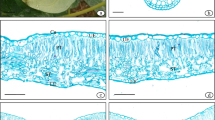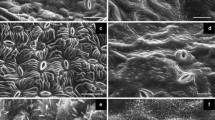Summary
-
(a)
Number of Silica cells per unit area in the lower epidermis of leaf midribs of thirteen varieties of sugarcane, covering a wide range of hardness of leaf midribs was noted. P.O.J. 2725,Sewari (Nargori group) and Co 299 had on the average, 39·4 to 41·4 of them in a circular field which was 470 µ in diameter, whereas in Co 331, Co 513 andChin (Saraitha group) the number was as low as 13·3 to 14·5 in the same area.
-
(b)
Silica cells were found to have no consistent association either with the weight required to puncture the midrib on its convex side or with the thickness of the outer cell wails, both the correlation coefficients being too tow to be significant even at 10%, level.
-
(a)
The range of the thickness of outer walls of long cells in the epidermis as expressed in the divisions of the eye-piece micrometer was from 14·5 inSewari (Nargori group) to 23·5 in Co 421 (I division = 0·22µ).
-
(b)
The varietal differences were significant at 5% level.
-
(a)
Weights required to puncture a midrib varied from 598 gm. inChin to 1273 gm. in Co 285 and these for the varieties studied were found to be significantly different at 5% level.
-
(b)
The correlation coefficient between this character and the thickness of cell walls was found to be + 0·6377 which was significant at the same level.
-
(c)
The thickness of outer wall of long cells of lower epidermis could, therefore, be used as a fairly reliable indicator of the puncture-weight and, therefore, of the hardness of a leaf midrib.
-
4.
The erratic behaviour of four varieties, namely Co 285, P.O.J. 2725,Chin andSaraitha (Saraitha group) in which the puncture-weights were found to be bisher or lower than those warranted by the thickness of cell walls was explained by the size and number of vascular bundles and the sclerenchymatous cuchions together with the thickness of sclerenchymatous cell walls when these characters were considered in relation to the size of a midrib in cross-section. All the four varieties were found to be abnormal for one character or the other.
Similar content being viewed by others
References
Isshc, P. V. “How midrib hardness affords resistance to the sugarcane top borer (Scirpophaga nivella F.) in India,”Curr. Sci., 1939,8, 211–2.
Khanna, K. L. “An Improved Instrument for Testing Rind Hardness, in Sugarcane,”Agr. and Live Stock in India, 1935,5, 156–8.
-Annl. Rept. Sug. Res. Sta., Bihar, 1940, 33–34.
-Ibid., 1941, 18–19.
Khanna, K. L., and Sharma, S. L. “Studies in the Anatomy of Sugarcane Stalk. I. Chewing Canes.”Proc. Ind. Acad. Sci., 1947,26, 13–31.
Puri, A. N., and Venkatraman, T. S.Proc. Com. Techmol. Assoc., India, 1929, 78–80.
Thuljaram Rao, J., and Venkatraman, T. S. “Hard leaf midrib in sugarcane and resistance to top-borer (Scirpophaga nivella F.),”Curr. Sci., 1941,10, 171–172.
Thuljaram Rao, J. “Leaf midrib structure of sugarcane as correlated wilh resistance to the top-borer (Scirpophaga nivella Fabr.),”Ind. J. Agr. Sci., 1947,17, 203–10.
Author information
Authors and Affiliations
Rights and permissions
About this article
Cite this article
Khanna, K.L., Sharma, S.L. Lower epidermis of leaf midrib as an imdicator of its hardness in sugarcane. Proc. Indian Acad. Sci. 30, 307–315 (1949). https://doi.org/10.1007/BF03051451
Received:
Issue Date:
DOI: https://doi.org/10.1007/BF03051451




